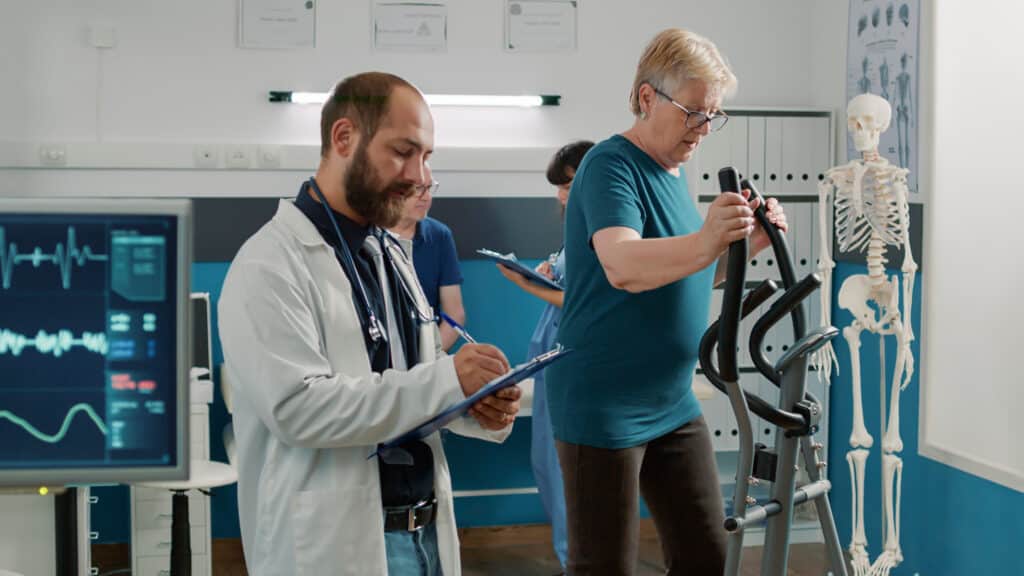Heart health becomes increasingly important as we age, and coronary artery disease (CAD) is a condition that many face without realizing its impact.
CAD can lead to symptoms like chest pain and shortness of breath, and it’s a leading cause of heart-related issues in the U.S.
With over $200 billion spent annually on CAD-related healthcare, understanding this condition and how to manage it is essential for staying healthy and active.
Physical therapy and cardiac rehabilitation are essential in managing CAD. Together, they help patients improve heart function, adopt healthier habits, and enhance their quality of life.
In this article we will explore CAD’s symptoms, risk factors, diagnostic methods, and the critical role of physical therapy and cardiac rehabilitation in recovery and long-term heart health.
What is Coronary Artery Disease, and How is it Diagnosed?

Coronary artery disease (CAD) is a common heart condition that occurs when the arteries supplying oxygen-rich blood to your heart muscle become narrowed or blocked.
This happens due to a buildup of cholesterol, fat, and other substances in the artery walls—a process known as atherosclerosis. Over time, this buildup—or plaque—hardens and narrows the arteries, reducing blood flow to the heart.
Common Red Flags
When your heart isn’t getting enough oxygen-rich blood, it can present several warning signs.
One of the most common is chest pain, called angina, which might feel like pressure, squeezing, or tightness. This pain can also spread to other areas, like your arms, neck, jaw, shoulder, or back.
In addition to chest pain, be aware of other symptoms, such as shortness of breath, unusual fatigue, dizziness, and sweating.
If a coronary artery becomes completely blocked, it can cause a heart attack, which can result in permanent damage to the heart muscle due to a lack of blood and oxygen.
Differences Between Men and Women
It’s important to recognize that heart symptoms can differ between men and women.
Men usually experience the classic symptoms, such as chest pain. Women, however, might have subtler signs, including shortness of breath, nausea, and pain in the back or jaw. Women may also feel unusually tired or experience flu-like symptoms.
These symptoms in women can be less obvious and sometimes overlooked, leading to delays in getting the necessary help. Understanding these differences is crucial for early detection and treatment.
Risk Factors for Coronary Artery Disease

Several factors can increase your risk of developing coronary artery disease (CAD). These include:
High blood pressure (hypertension) is one of the most common risk factors for CAD. It puts extra strain on your artery walls, speeding up the hardening and narrowing of the arteries and making it harder for blood to flow to your heart.
High Cholesterol: High levels of low-density lipoprotein (LDL) cholesterol, often called “bad” cholesterol, can lead to plaque buildup in your arteries. Low levels of high-density lipoprotein (HDL) cholesterol, often called “good” cholesterol, can also increase your risk of CAD.
Smoking: Smoking introduces harmful chemicals into your body that damage the lining of your arteries. This damage leads to plaque buildup and reduces the oxygen in your blood, making your heart work harder.
Diabetes: High blood sugar levels can damage your blood vessels and the nerves that control your heart, raising your risk of CAD.
Sedentary Lifestyle: Not getting enough physical activity can weaken your heart and harm your cardiovascular health. Inactivity also contributes to high blood pressure.
Unhealthy Diet: Eating a diet high in saturated fats, trans fats, and cholesterol can cause plaque to build up in your arteries, increasing your risk of CAD.
Genetics: Family history plays a significant role in your risk of developing CAD. Men tend to be at higher risk earlier in life, but for women, the risk increases and can even surpass men after menopause.
How Coronary Artery Disease is Diagnosed
Diagnosing coronary artery disease (CAD) typically starts with your doctor asking about your symptoms, lifestyle, and family history of heart disease, followed by a physical examination.
To confirm the diagnosis and assess the severity of the disease, your doctor may order several tests:
- Electrocardiogram (ECG): This test records the electrical activity of your heart. It can reveal if your heart muscle is damaged or beating irregularly.
- Stress tests monitor your heart’s activity while you exercise, usually on a treadmill. They help doctors see how your heart responds to physical exertion and whether there are any issues with blood flow to your heart during exercise.
- Echocardiogram: This test creates images of your heart using sound waves, showing how well it’s pumping and whether any parts of your heart muscle are damaged.
- Coronary Angiography: This special X-ray test involves injecting dye into your coronary arteries to check for blockages or narrowing that could restrict blood flow to your heart.
Why Early Detection Matters
Spotting the risk factors for coronary artery disease (CAD) early is essential. Early detection allows you to start treatment and make lifestyle changes to prevent the disease from worsening and lower your risk of serious complications.
Regular check-ups, eating a heart-healthy diet, staying active, quitting smoking, and managing conditions like high blood pressure and diabetes are all key to preventing and controlling CAD.
Early detection can reduce the risk of serious complications like heart attacks. If you have any symptoms or risk factors for CAD, it’s important to talk to your doctor and get tested.
How Physical Therapy Helps with Coronary Artery Disease

Physical therapy plays a crucial role in managing coronary artery disease.
Physical therapists (PTs) collaborate closely with cardiologists and other healthcare professionals to develop personalized treatment plans that improve heart health, enhance mobility, and reduce the risk of future heart problems.
Improving Heart Function
One of the primary benefits of physical therapy for individuals with CAD is improving heart function. PTs create exercise programs that gradually increase your exercise capacity, helping your heart work more efficiently.
This is especially important if you’re recovering from a heart attack or heart surgery, as it aids in heart healing and helps you return to your daily activities more quickly.
Enhancing Quality of Life
Regular exercise, guided by your PT, can reduce symptoms like chest pain (angina) and shortness of breath, making it easier to carry out everyday tasks.
PTs also teach you to maintain an active lifestyle and adopt heart-healthy habits, such as eating a balanced diet and managing stress.
This holistic approach addresses the physical aspects of CAD and empowers you to take control of your overall health and well-being.
What to Expect From Exercise Testing for Coronary Artery Disease

Exercise testing is crucial for understanding how coronary artery disease (CAD) affects the heart.
These tests are typically administered by exercise physiologists or conducted through the cardiology department at a hospital or clinic.
They determine how your heart responds to physical activity, aiding in determining the severity of your condition and assessing overall heart health.
While PTs typically do not administer exercise stress tests, they use the results of these tests (often provided by the cardiologist or exercise physiologist) to design personalized exercise programs for patients.
What Happens During an Exercise Test?
During an exercise test, you might be asked to walk on a treadmill or pedal a stationary bike. While you exercise, your heart rate, blood pressure, and heart rhythm (monitored through an electrocardiogram or ECG) are closely observed.
One common test is the treadmill test, also known as the exercise stress test. The intensity gradually increases as you exercise, making your heart work harder. This test can reveal any issues with your heart’s function, which might indicate the presence of CAD.
Why Are These Tests Important?
These tests are important because they show how well blood flows to your heart and can help identify areas where blood flow might be reduced.
They also assist your healthcare team in understanding the severity of your CAD and whether your current treatments are effective.
Physical Therapy and Cardiac Rehabilitation
Cardiac rehabilitation (CR) is a vital part of recovery for individuals with coronary artery disease or who have undergone heart surgery. This comprehensive program improves heart health, reduces future cardiac risks, and enhances overall quality of life.
Physical therapy (PT) is a key component of CR, guiding patients through safe and effective exercise routines. The multidisciplinary CR team addresses the full spectrum of cardiovascular health.
The Phases and Roles in Cardiac Rehabilitation
Cardiac rehabilitation (CR) is a comprehensive, multidisciplinary program designed to improve the overall cardiovascular health of patients with coronary artery disease or those recovering from heart-related procedures.
While physical therapy is crucial to CR, it is only one element of a broader program that includes medical evaluations, prescribed exercise, cardiac risk factor management, education, and psychological support.
Phases of Cardiac Rehabilitation

Phase 1: In-Hospital Care
This phase begins immediately after a cardiac event or surgery, such as a heart attack or coronary artery bypass grafting (CABG), while the patient is still in the hospital.
Physical therapists initiate gentle exercises to prevent deconditioning, promote circulation, and encourage early mobilization.
They also educate patients on safe movement practices to prevent complications like blood clots and pneumonia and assist with respiratory therapy to improve lung function.
The goal is to stabilize the patient’s condition and prepare them to transition to the next rehabilitation phase.
Phase 2: Outpatient Care
After hospital discharge, the focus shifts to gradually increasing physical activity levels in an outpatient setting.
PTs supervise exercise sessions tailored to patients’ needs, ensuring safety and effectiveness. This phase also includes education on heart-healthy living, covering topics like nutrition, smoking cessation, and stress management.
The goal is to gradually increase physical activity while helping patients adopt and maintain healthier lifestyle habits.
Phase 3: Long-Term Maintenance
This phase builds on the progress made in earlier stages, focusing on maintaining long-term cardiovascular health.
PTs provide ongoing support and guidance as patients continue to exercise regularly and adhere to personalized health plans. The goal is to sustain improvements in cardiovascular health and prevent further heart complications.
Creating a Personalized Exercise Plan

Your healthcare team, including physical therapists, uses a collaborative approach to develop a safe and effective exercise plan tailored to your needs.
This personalized approach ensures that you can safely increase your activity levels, improve your heart health, and enhance your overall well-being after diagnosis or surgery if needed.
Exercise and Lifestyle Modifications
Regular exercise is vital for people with coronary artery disease (CAD) to improve heart health and reduce the risk of future heart problems.
Physical therapists often recommend a combination of exercises, including aerobic activities like walking, cycling, and swimming, as well as strength training and flexibility exercises.
It’s important to start slowly and gradually increasing your workouts’ intensity and duration.
In addition to exercise, making lifestyle changes—such as quitting smoking, eating a balanced diet, managing stress, and maintaining a healthy weight—can significantly enhance the benefits of physical therapy and improve your overall heart health.
Real-Life Recovery: Mary’s Journey Back to Health
Hearing real-life success stories can be incredibly motivating, especially when facing a challenge like coronary artery disease rehabilitation.
Take Mary, for example, a 58-year-old woman who underwent coronary artery bypass grafting (CABG) surgery.
The days following her surgery were tough—simple movements were exhausting and required immense effort.
However, her physical therapy sessions in the ICU, though difficult, were crucial in laying the foundation for her recovery. Mary often mentioned how the encouragement and guidance she received helped her push through those tough early days, gradually improving her mobility and strength.
When Mary moved to the outpatient phase of her cardiac rehabilitation, she began participating in supervised exercise sessions. These sessions and education on heart-healthy living played a significant role in her recovery.
Not only did she regain her physical strength, but she also built confidence. Over time, Mary achieved significant milestones, like resuming her cherished long walks around the neighborhood.
She also adopted new, healthy habits, including a balanced diet and stress management techniques like yoga and meditation.
Through consistent effort and support from her physical therapy team, Mary successfully returned to her daily activities and embraced a healthier lifestyle, demonstrating cardiac rehabilitation’s profound impact on recovery.
Key Takeaways
- Coronary artery disease (CAD) is a common heart condition where the coronary arteries become narrowed or blocked, typically due to plaque buildup.
- Plaque buildup inside the arteries reduces blood flow to the heart, which can cause chest pain (angina) and other symptoms.
- Symptoms of CAD can differ between men and women; men often experience chest pain, while women may have subtler signs like shortness of breath, nausea, and fatigue.
- Several risk factors increase the likelihood of developing CAD, including high blood pressure, high cholesterol, smoking, diabetes, lack of physical activity, and an unhealthy diet.
- Early detection of CAD is crucial for effective treatment and lifestyle changes, preventing the condition from worsening and reducing the risk of heart attacks.
- Diagnosing CAD typically involves a physical examination and tests such as electrocardiograms (ECG), stress tests, echocardiograms, and coronary angiography.
- Physical therapy (PT) is key in managing CAD by improving heart function, enhancing quality of life, and helping patients adopt heart-healthy habits.
- Cardiac rehabilitation (CR) is a comprehensive program that includes physical therapy and other interventions to improve heart health and prevent future complications.
- Regular exercise and lifestyle modifications, such as quitting smoking, eating a balanced diet, and managing stress, are essential for improving heart health in CAD patients.
FAQs
What is coronary artery disease (CAD), and how does it develop?
Coronary artery disease (CAD) occurs when the coronary arteries, which supply blood to the heart, become narrowed or blocked due to plaque buildup. This buildup, made of cholesterol, fat, and other substances, hardens over time, reducing blood flow and leading to symptoms like chest pain (angina) and shortness of breath.
What are the common symptoms of coronary artery disease?
Common symptoms of CAD include chest pain or discomfort (angina), shortness of breath, fatigue, dizziness, and sweating. Symptoms may sometimes extend to the arms, neck, jaw, or back. Men typically experience chest pain, while women may have subtler symptoms, such as shortness of breath and nausea.
How is coronary artery disease diagnosed?
CAD is diagnosed through a combination of medical history, physical examination, and diagnostic tests. These tests may include an electrocardiogram (ECG) to assess heart activity, a stress test to evaluate how the heart performs under physical exertion, an echocardiogram to create images of the heart, and coronary angiography to detect blockages in the arteries.
Can lifestyle changes help manage or prevent coronary artery disease?
Yes, lifestyle changes are crucial in managing and preventing CAD. These include adopting a heart-healthy diet, engaging in regular physical activity, quitting smoking, managing stress, and maintaining a healthy weight. These habits can reduce risk factors such as high blood pressure, high cholesterol, and diabetes.
What role does physical therapy play in managing coronary artery disease?
Physical therapy aids in managing CAD by improving heart function, enhancing mobility, and promoting overall heart health. Physical therapists create personalized exercise programs that help patients gradually increase their physical activity, reduce symptoms like chest pain, and adopt healthier habits that contribute to long-term well-being.
References
- Mehta, Laxmi S et al. “Acute Myocardial Infarction in Women: A Scientific Statement From the American Heart Association.” Circulation vol. 133,9 (2016): 916-47. doi:10.1161/CIR.0000000000000351
- Pinkstaff, S., PT, DPT, PhD. (2017). Coronary Artery Disease (CAD). American Association of Physical Therapy, Clinical Summaries. https://www.apta.org/patient-care/evidence-based-practice-resources/clinical-summaries/coronary-artery-disease-cad
- Winzer, E. B., Woitek, F., & Linke, A. (2018). Physical activity in the prevention and treatment of coronary artery disease. Journal of the American Heart Association, 7(4), e007725.
- Francis, T., Kabboul, N., Rac, V., Mitsakakis, N., Pechlivanoglou, P., Bielecki, J., … & Krahn, M. (2019). The effect of cardiac rehabilitation on health-related quality of life in patients with coronary artery disease: a meta-analysis. Canadian Journal of Cardiology, 35(3), 352-364.






